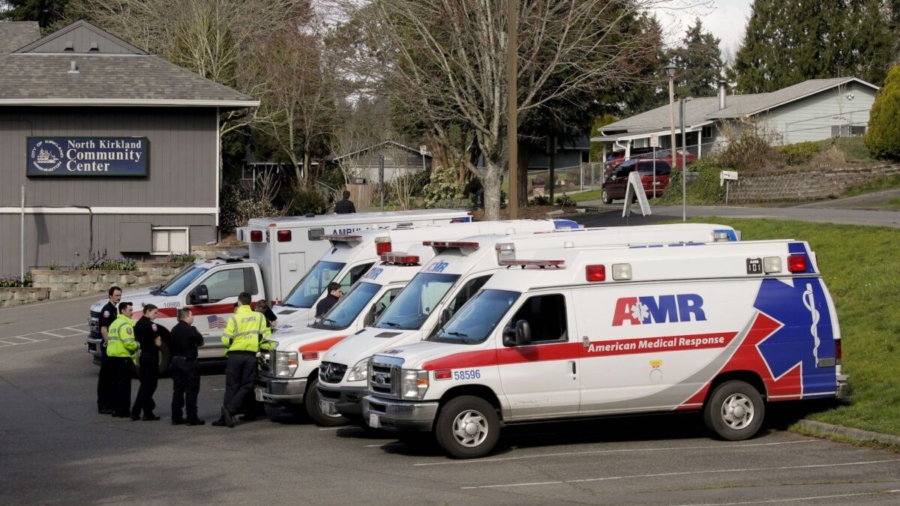As coronavirus deaths in the United States rose to 11 on Wednesday, the majority of which were in Washington state, the state’s health department said its hospitals have the capacity to deal with the crisis.
“Hospitals all have differing capacities for accepting patients. There are many hospitals in Washington equipped to accept patients with infectious diseases,” Danielle Koenig with the Washington State Department of Health told The Epoch Times in an email.
“The reason some COVID-19 cases were sent to Spokane [Providence St. Joseph Health] last month is because that hospital is one of 10 in the nation with a highly specialized setup,” said Koenig.
In an effort to reduce the burden on hospitals, public health officials in Washington state have asked that people who believe they may have the virus to first get tested by their health care provider and self-isolate at home, instead of heading straight to an emergency room, Koenig said.
“King County and the state have both identified or set up isolation facilities where people who are mildly sick or are recovering can stay to free up hospital capacity for those who need it most,” she said.
On Wednesday, at least 130 known coronavirus cases were reported from 13 states, while five among the dead had ties to a single place—the Life Care Center, a long-term nursing home in a Seattle suburb.

In New York, the number of cases of infection rose to 11 on Wednesday and the State Health Department told The Epoch Times that it’s preparing to monitor its hospital capacity over the crisis.
“The Department has implemented a process to monitor hospital capacity including tracking the number of vacant hospital beds, number of isolation units, as well as emergency department activity,” said Jill Montag, a spokesperson for the Department.
“The Department will continue tracking these measures and will continue working with the hospital community to ensure continuity of health care services,” she said.
Montag said the State Department maintains a stockpile of medical equipment including personal protective equipment (PPE), ventilators, and antivirals.
“During the current COVID-19 response, the Department has already supplied hospitals across the state with N-95 respirators and other PPE to help mitigate any supply shortages currently being realized due to COVID-19,” she said.
Capacity Varies From State to State: Expert
While the officials expressed confidence in dealing with the crisis, one expert said the hospital capacity varies from state to state, and there are marked differences between preparedness in urban and rural areas.
“If the number of coronavirus patients requiring in-hospital care is low or moderate, owing to containment of the spread of the disease through better monitoring and in-home quarantines, most hospitals will be able to manage demands on them,” Alan Sager, Director of the Health Reform Program of Boston University’s School of Public Health told The Epoch Times in an email.
“But even this will vary enormously from state to state. Oregon and Washington are the two lowest states in acute hospital bed/population ratios. California’s also near the bottom,” he said.
Sager noted that there are 800,000 licensed beds in the United States and the average daily census of occupancy in 2018 was 507,700.
“That suggests almost 300,000 empty beds on an average day, ready to serve patients. But that’s not so.
“The 300,000 empty beds are not staffed and hospitals would have to persuade RNs [registered nurses] to work overtime or hire more RNs to care for patients,” he explained.
Sager said this may further vary as the bed occupancy is higher during the weekdays and during the winters but lower during the summer and weekends.
“Many years, hospitals are stretched to capacity in some parts of the nation by the winter flu. Will they have the capacity to stretch further to care for patients with breathing or other problems stemming from coronavirus that can’t be managed safely at home?” he said.
Sager said that the situation of hospitals in rural areas is further worrisome as they have historically been clinically and financially stressed.
“The two stresses are connected. Many rural areas have been losing doctors to relocation, retirement, and death; too few doctors have replaced those departing. Without doctors to admit and care for patients, hospitals suffer declines in delivery of needed care, patients, and revenue,” he said.
Sager expressed optimism, however, and said that the $4 trillion spent on U.S. healthcare in 2020 is five times more than defense spending this year and is sufficient for pay for healthcare for everyone.
“It’s time to make sure that money is spent well—to do as much as possible to protect the health of the public from infectious diseases and all the other ills that can afflict humans,” he said.
From The Epoch Times


